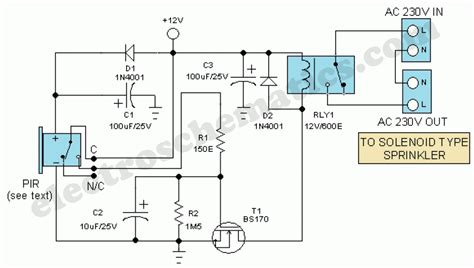What is a Motion Sensor Circuit?
A motion sensor circuit is an electronic device that detects the presence of motion in its vicinity. It comprises a sensor, which can be either a passive infrared (PIR) sensor or a microwave sensor, and a control circuit that processes the sensor’s output and triggers a response based on the detected motion.
Types of Motion Sensors
-
Passive Infrared (PIR) Sensors: PIR Sensors detect changes in infrared radiation emitted by objects in their field of view. When an object with a different temperature than the background, such as a human or animal, moves within the sensor’s range, it triggers the sensor.
-
Microwave Sensors: Microwave sensors emit high-frequency electromagnetic waves and measure the reflected waves’ frequency shift. When an object moves within the sensor’s range, it alters the reflected waves’ frequency, allowing the sensor to detect motion.
Setting Up a Motion Sensor Circuit
To set up a basic motion sensor circuit, you will need the following components:
- PIR sensor module
- Arduino board (or any other microcontroller)
- Jumper wires
- Breadboard (optional)
- LED (optional, for visual indication)
Step-by-Step Guide
- Connect the PIR sensor module’s VCC pin to the Arduino’s 5V pin.
- Connect the PIR sensor module’s GND pin to the Arduino’s GND pin.
- Connect the PIR sensor module’s OUT pin to one of the Arduino’s digital input pins (e.g., pin 2).
- Optional: Connect an LED to one of the Arduino’s digital output pins (e.g., pin 13) and GND.
- Upload the following code to the Arduino:
int pirPin = 2; // PIR sensor connected to digital pin 2
int ledPin = 13; // LED connected to digital pin 13
void setup() {
pinMode(pirPin, INPUT);
pinMode(ledPin, OUTPUT);
Serial.begin(9600);
}
void loop() {
int pirValue = digitalRead(pirPin);
if (pirValue == HIGH) {
digitalWrite(ledPin, HIGH);
Serial.println("Motion detected!");
} else {
digitalWrite(ledPin, LOW);
Serial.println("No motion.");
}
delay(500);
}
This code continuously reads the PIR sensor’s output and prints “Motion detected!” when motion is detected, and “No motion.” otherwise. If an LED is connected, it will turn on when motion is detected and turn off when no motion is detected.
Applications of Motion Sensor Circuits
Motion sensor circuits find applications in various domains, including:
Home Security Systems
Motion sensors are a crucial component of home security systems. They can detect unauthorized entry and trigger alarms, alerts, or notifications to the homeowner or security service provider.
Automated Lighting Control
Motion sensor circuits can be used to control lighting in rooms, hallways, or outdoor areas. When motion is detected, the lights turn on automatically, and when no motion is detected for a set period, the lights turn off, saving energy.
Energy-Saving Devices
Motion sensors can be integrated into various devices to save energy. For example, in air conditioning systems, motion sensors can detect the presence of people in a room and adjust the temperature accordingly, reducing energy consumption when the room is unoccupied.
Robotics and Automation
Motion sensors are used in robotics and automation to detect the presence of objects or people. They can be used for obstacle avoidance, human-robot interaction, or triggering specific actions based on motion detection.
Automotive Industry
In the automotive industry, motion sensors are used for various purposes, such as activating automatic doors, triggering parking assistance systems, or detecting the presence of passengers for airbag deployment.

Frequently Asked Questions (FAQ)
-
What is the difference between a PIR sensor and a microwave sensor?
PIR sensors detect changes in infrared radiation emitted by objects, while microwave sensors emit and measure the reflection of high-frequency electromagnetic waves to detect motion. -
Can motion sensors detect motion through walls?
Most standard motion sensors cannot detect motion through walls, as walls block infrared radiation and attenuate microwave signals. However, specialized sensors with higher sensitivity or different technologies may be able to detect motion through thin walls or obstacles. -
How can I adjust the sensitivity of a motion sensor circuit?
Many motion sensor modules, especially PIR sensors, have built-in potentiometers that allow you to adjust the sensitivity. Consult the sensor’s datasheet or documentation for specific instructions on how to adjust the sensitivity. -
Can motion sensors be used outdoors?
Yes, motion sensors can be used outdoors, but it is essential to choose sensors specifically designed for outdoor use. Outdoor motion sensors should be weatherproof, have a suitable detection range, and be able to distinguish between human motion and other moving objects like trees or small animals. -
How can I reduce false triggers in a motion sensor circuit?
To reduce false triggers, you can: - Adjust the sensor’s sensitivity to an appropriate level.
- Ensure the sensor is not facing direct sunlight, heat sources, or moving objects like fans or curtains.
- Use software techniques, such as time-based filtering or comparing multiple sensor readings, to filter out false positives.
Conclusion
Motion sensor circuits are essential components in various applications, from home security and automation to energy-saving devices and robotics. By understanding the fundamentals of motion sensors and their setup, you can create your own motion-sensing projects or integrate them into existing systems. As technology advances, motion sensors will continue to play a crucial role in making our lives safer, more convenient, and more energy-efficient.

No responses yet